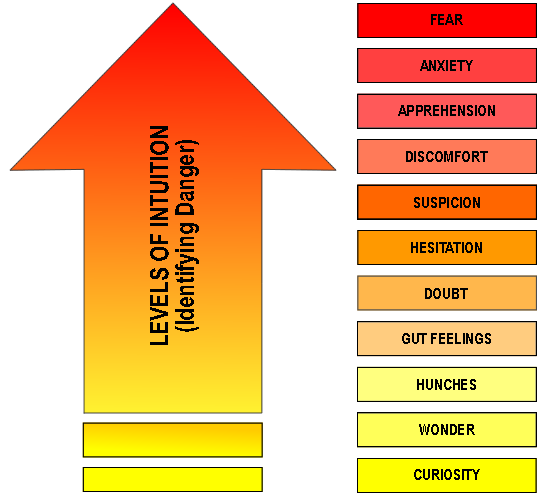|
|||||||

Be Prepared / The Three A's - Teen Dating Violence
Awareness
Awareness is a knowledge of people and the environment in the immediate vicinity. Ideally, awareness helps an individual to circumvent and remove herself from a potentially harmful situation.
- Scan The Area. And keep scanning. Keep your eyes up. Look around. Pay attention to what and who is nearby. Make it a habit to always look around.
- People. Who is nearby? What are they doing? Where are they going?
- Comfort Zone. How close can people be to you before you feel uncomfortable? Where are your “comfort zone” boundaries?
- Doors and Windows. How many doors are nearby? Where are the doors? Where is the entrance and exit?
- Distracted. Don’t be distracted or preoccupied with other tasks (Vogt, 15).
- Intuition. Put it all together with intuition.
INTUITION
Pay attention to all the “funny feelings” that we usually ignore.
- Definition. Intuition is “the power or faculty of attaining to direct knowledge or cognition without evident rational thought and inference.”
- Significance. Intuition provides significance to observations by bringing awareness of the world around us to a conscious level.
- Primary signals. Curiosity, Wonder, Discomfort, Anxiety, Fear. Pay attention to these signals.
- Why it’s dulled. Attentiveness to intuition is ignored because the signal is dulled by judgment and rationalization. “We deny because we’re built to see what we want to see.” (32)
- Trust the Gut. Recognize, acknowledge, and trust the “gut feeling,” the feeling an individual has when something is not right. If something does not “feel” right, it probably isn’t right.

Assessment: Who, What, Where?
- Assessment is the consideration of the people and environment relative to an individual’s personal safety.
- Be aware of and have knowledge about the “enemy” and the environment before “quickly and accurately evaluating a specific situation in which [women] feel at risk. The more skillful [they] are in reading dangerous situations and people, the more likely [they] are to extricate [themselves] before violence occurs” (Nelson: 2).
- Pay attention to both verbal and non-verbal methods of communication.
| Scanning for Safety: Pay Attention! | |
|---|---|
| Immediate Environment | Escape Routes. Doors? Windows? Indoors? Outdoors? Lighting? Other People? Number, proximity, and identity of other people. Help or threat? Large objects. Barriers for protection such as desks, beds, couch, table, etc. Small objects. Weapons for you or others? Time of day. Day? Night? Dusk? Morning? Visibility? Other people nearby? Evidence of substance abuse or intoxication. Bottles? Needles? |
| Threatening Individual | Identity. Is this person known? What is known about them? Positioning & Proximity. Is another person(s) blocking the escape route(s)? Size, Strength, & Conditioning. Does the attacker appear fit? Demeanor, Stance, & Posture. How do they look? Jaws clenched? Blinking? Emotional State. Agitated? Angry? Frustrated? Confused? Irrational? Gait & Gestures. How are they walking? Unsteady? What are their hands doing? Clothing. What message do their clothes convey? Speaking. How and what? Loud and belligerent? Slurred speech? Possession of Weapons. Does it look like they have a weapon? Get away! |
| Yourself | Strengths. Run fast? Hit hard? Scream loud? Kick well? Presence of mind in stressful situations? Skills. Speaking/Communication? Martial arts? Feeling state. Remain calm? Think clearly re: options and possible outcomes? |
In The News
Recommended Resources













